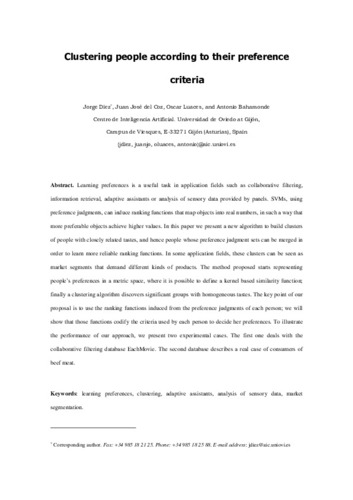Clustering people according to their preference criteria
Autor(es) y otros:
Palabra(s) clave:
Learning preferences
Clustering
Adaptive assistants
Analysis of sensory data
Market segmentation
Fecha de publicación:
Editorial:
Elsevier
Versión del editor:
Citación:
Descripción física:
Resumen:
Learning preferences is a useful task in application fields such as collaborative filtering, information retrieval, adaptive assistants or analysis of sensory data provided by panels. SVMs, using preference judgments, can induce ranking functions that map objects into real numbers, in such a way that more preferable objects achieve higher values. In this paper we present a new algorithm to build clusters of people with closely related tastes, and hence people whose preference judgment sets can be merged in order to learn more reliable ranking functions. In some application fields, these clusters can be seen as market segments that demand different kinds of products. The method proposed starts representing people’s preferences in a metric space, where it is possible to define a kernel based similarity function; finally a clustering algorithm discovers significant groups with homogeneous tastes. The key point of our proposal is to use the ranking functions induced from the preference judgments of each person; we will show that those functions codify the criteria used by each person to decide her preferences. To illustrate the performance of our approach, we present two experimental cases. The first one deals with the collaborative filtering database EachMovie. The second database describes a real case of consumers of beef meat
Learning preferences is a useful task in application fields such as collaborative filtering, information retrieval, adaptive assistants or analysis of sensory data provided by panels. SVMs, using preference judgments, can induce ranking functions that map objects into real numbers, in such a way that more preferable objects achieve higher values. In this paper we present a new algorithm to build clusters of people with closely related tastes, and hence people whose preference judgment sets can be merged in order to learn more reliable ranking functions. In some application fields, these clusters can be seen as market segments that demand different kinds of products. The method proposed starts representing people’s preferences in a metric space, where it is possible to define a kernel based similarity function; finally a clustering algorithm discovers significant groups with homogeneous tastes. The key point of our proposal is to use the ranking functions induced from the preference judgments of each person; we will show that those functions codify the criteria used by each person to decide her preferences. To illustrate the performance of our approach, we present two experimental cases. The first one deals with the collaborative filtering database EachMovie. The second database describes a real case of consumers of beef meat
ISSN:
Identificador local:
1023
Colecciones
- Artículos [37541]
- Informática [875]
Ficheros en el ítem




